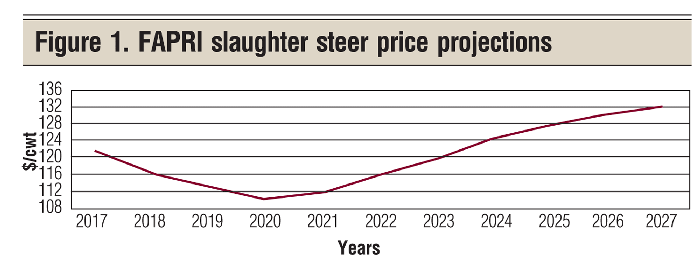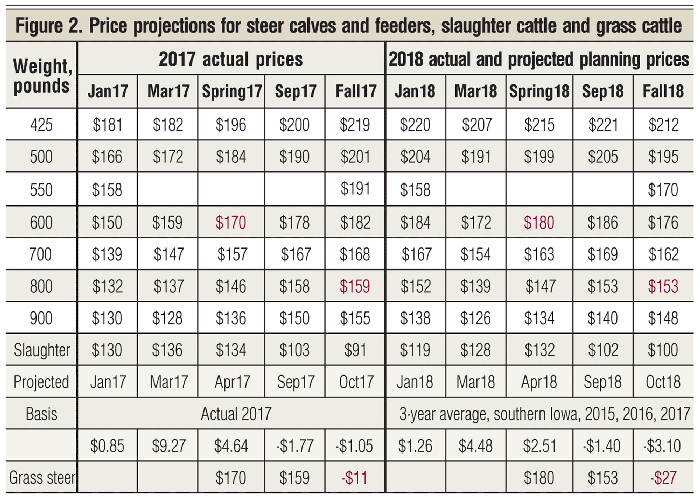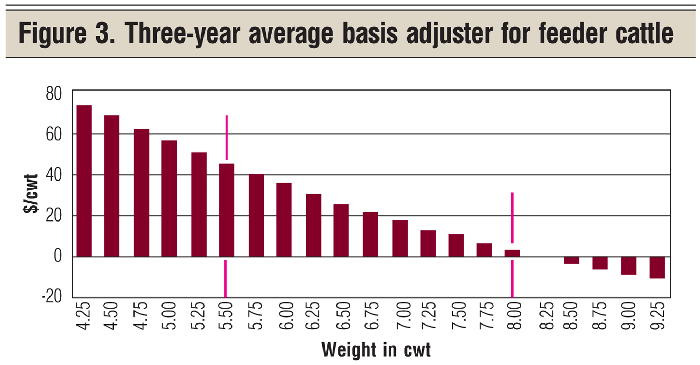Harlan helps break down the numbers and shares tips on projecting feeder cattle prices in 2018.
June 8, 2018

Let’s take a simplified approach to looking at price projections. First, the long run.
Spring 2018 projections from the Financial and Policy Research Institute (FAPRI) at the University of Missouri are now suggesting that annual slaughter cattle prices might not bottom out until the year 2020, making the current cycle a 13-year event. FAPRI also suggests annual slaughter cattle prices could average $115 per cwt in 2018, $113 in 2019 and $110 in 2020 (Figure 1).

FAPRI further suggests that the next cycle may peak sometime in the 2028 era. Drought in cow country is the biggest factor that can directly change these projections.
This is fine for a long-run perspective. Let’s now focus on a short-run perspective for feeder cattle.
Figure 2 presents my latest short-run feeder cattle price projections generated in my latest monthly price analysis. Most of the table values are devoted to feeder steer prices. Slaughter price projections are near the bottom, along with suggested slaughter cattle basis (cash minus futures). Grass steer price projections are at the bottom, and are used for budgeting going on grass and coming off grass each growing season.

The red numbers in the feeder price section are my planning prices used for going on grass in the spring and coming off grass in the fall. The bottom-line red numbers are the sell-buy margin (price off grass minus price on grass) for grass cattle, used to estimate the marketing loss on the original purchase weight.
Quick price projection update
Since you’re reading this article later than the projections were generated, you might want to do a quick update of the projected selling price for grass cattle to see how things have changed from these late-April 2018 projections.
Let’s focus on an October price for selling your grass steers off grass — the $153-per-cwt red number in the Fall ’18 column in Figure 2. When the $180 Spring ’18 price going on grass is compared with the projected $153 off-grass price in Fall ’18, the buy-sell margin is a minus $27.
This means with a 600-pound feeder going on grass at $180 per cwt and an 800-pound feeder off grass at $153 per cwt, I am projected to have a marketing loss on the original purchased 600-pound feeder of (−$27 x 6.00 cwt) equal to $162 per head. I have to make this up on the 200 pounds of gain. This figures out to a marketing loss of $81 per cwt of gain.
My projected total grazing cost of gain is $60 per cwt, including an annual grass rental charge of $90 per head, making my marketing loss plus cost of gain equal to $141 per cwt of gain. The buy-sell margin loss is even greater than the actual cost of gain. A market price of $153 and a total production cost of $141 leaves profit of only $12 per cwt of gain, or a projected $24 profit per head from running grass steers based on late-April price projections.
Let’s say on July 15 you look at Feeder Cattle futures prices and see that October Feeder Cattle futures price that day closed at $165 per cwt. Feeder Cattle futures prices are for 800-pound feeders, but you hope to market an 850-pound feeder off grass. So, how do we adjust the Feeder Cattle futures price for an 850-pound feeder in the cash market?
We can use a “basis adjuster” to generate a price adjustment for the cash market and the extra 50 pounds of weight. How I make the basic adjustment in my computer models is shown in Figure 3.

Basis is defined as cash minus futures. Each mid-month, I calculate the eastern Wyoming-western Nebraska basis (sale barn cash price minus the current Feeder Cattle futures price) for sale barn feeders from 425 pounds to 925 pounds, and my calculated last three-year average basis by feeder weight, as shown in Figure 3.
Now let’s say that on July 15, I see that Feeder Cattle futures for October closed at $165 per cwt. Now I want to adjust this futures price to project the eastern Wyoming-western Nebraska sale barn cash price for when I sell in October.
Let’s assume it has been a good grazing season, and I expect to sell 850-pound feeders off grass rather than 800-pound feeders. My calculations suggest a three-year basis average for an 850-pound feeder of a minus $2.65. So my new July 15 price forecast for an 850-pound feeder steer in October is ($165-$2.65 = $162.35), rounded to $162 per cwt. This is my updated projected sale barn price for grass cattle weighing 850 pounds.
This new price projection takes all of five minutes to get a quick updated price forecast for selling your steers off grass. Write down your projections in your pocketbook so that you can see the developing trend as you do this once a week or once a month during grazing season. This price trend is important to plant in your mind and helps you think through your current marketing program for your grass cattle.
Update fall price projections
Let’s use this same system to update my weaning price projections of $185 per cwt in Figure 2 for 550-pound steer calves off the cow in October. Let’s assume that on Sept. 1 you get the closing Feeder Cattle futures price for October for that day, and it is $140 per cwt. But, once again, you need to adjust this futures price for 800-pound steer feeders to a cash sale barn price for 550-pound steer calves.
Figure 3 suggests that the three-year basis for 550-pound feeders is $39.62. Add $39.62 to the Feeder Cattle futures price of $165 per cwt and you get a new sale barn cash price forecast of $179.62, rounded to $180 for an October steer calf price.
With this up-to-date price projection, you can start evaluating alternatives for marketing your fall-weaned calves. Should you sell at weaning, background or retain? You can use this quick pricing technique to get some planning prices for marketing alternatives for your 2018 calves.
A similar approach works even better to project slaughter cattle prices, by using Live Cattle futures and Live Cattle basis numbers, readily available on the internet from various university Extension services, such as Iowa State University and Kansas State University.
Price watching, if it is easy and applies directly to your cattle, can become addictive and is a very useful cattle marketing tool.
Words of caution: The variation of the basis adjustments is high, and as the variation of these basis numbers goes up, it reduces the quality of the projected planning prices. This implies that you should concentrate more on the price trend through the production year than on the absolute projected price levels.
Hughes is a North Dakota State University professor emeritus. He lives in Kuna, Idaho. Reach him at 701-238-9607 or [email protected].
About the Author(s)
You May Also Like





